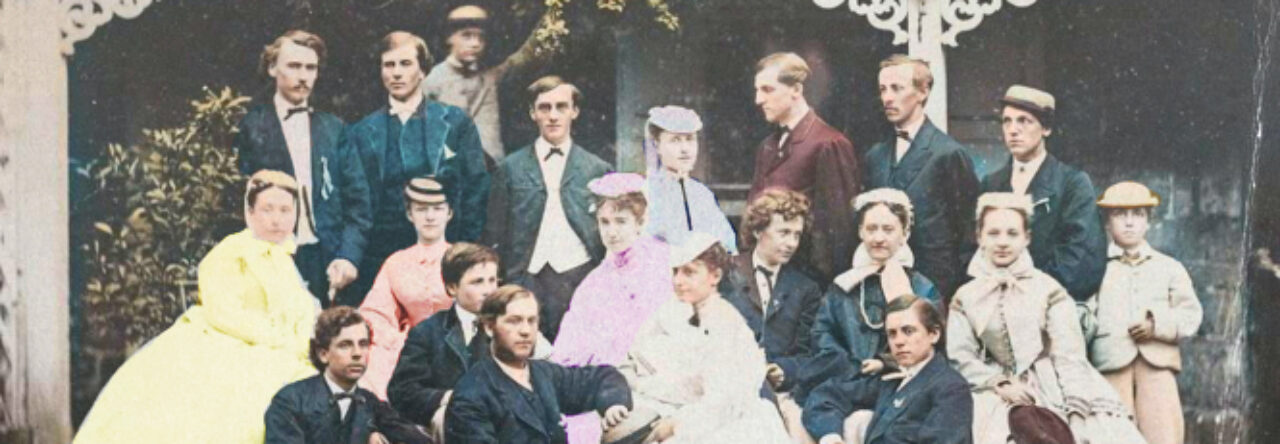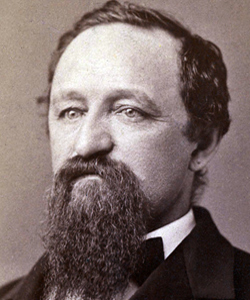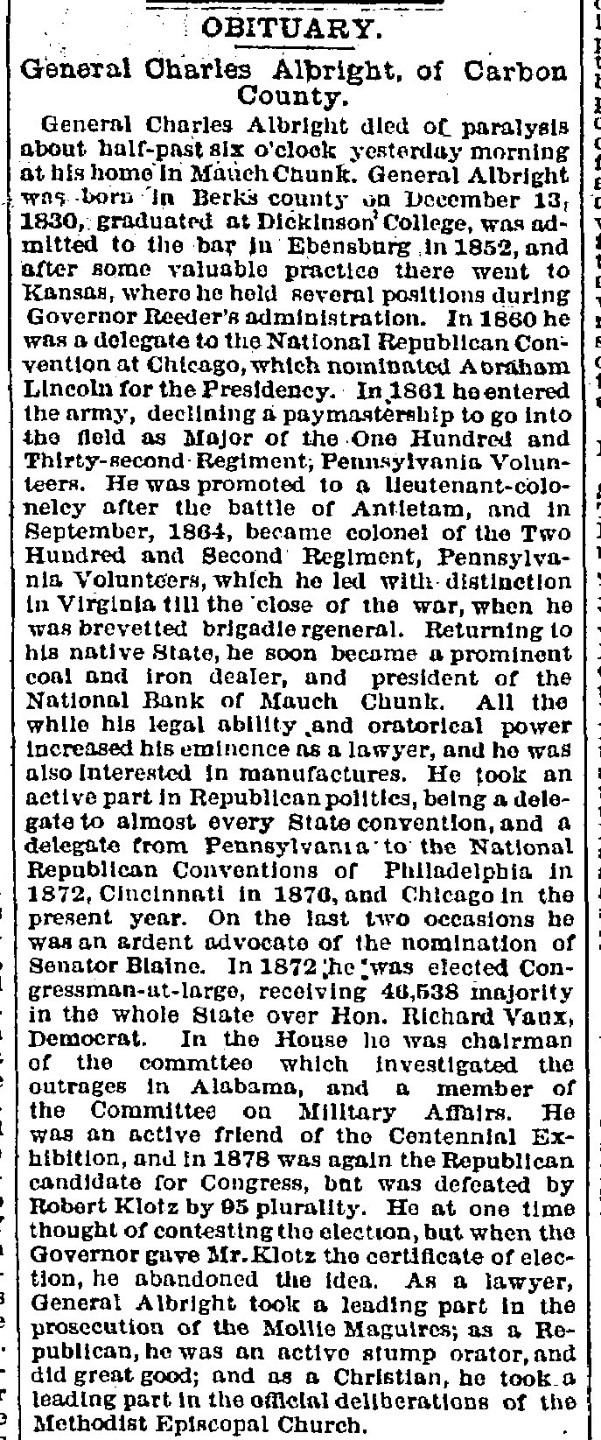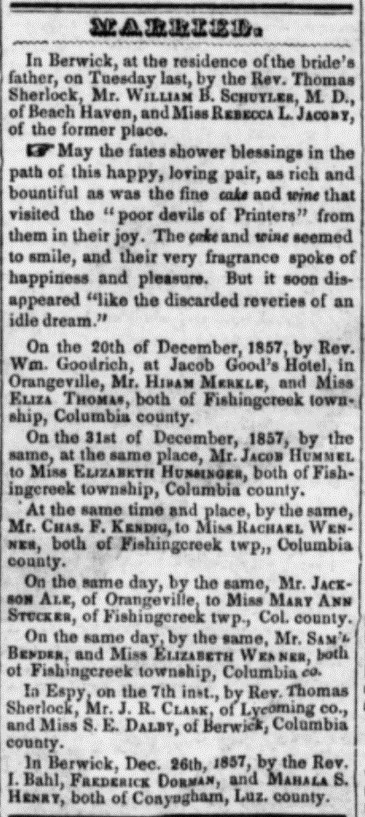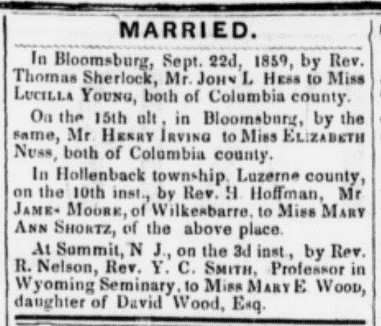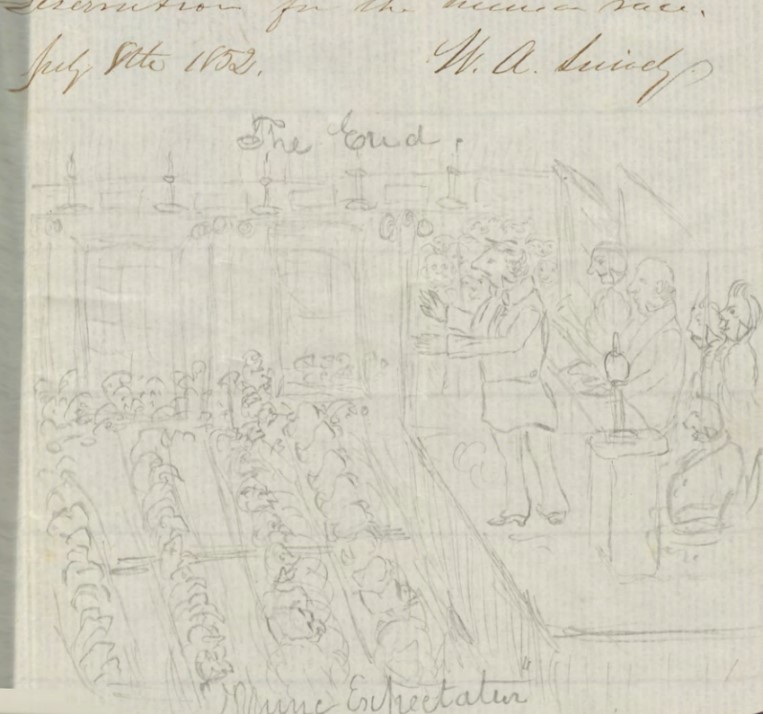The Dickinson Class of 1852 contains many different men from a vast varieties of backgrounds. The class contained 21 graduates with 34 non-graduates. The 21 graduates were all very active in extracurricular activities. Out of all 21 men who graduated only three of them were not in either the Belles Lettres Society, Union Philosophical Society or Zeta Psi Fraternity. It would definitely be interesting to research more into these clubs to figure out what exactly appealed to the 18 members of their class. Some of the students were part of both a society and Zeta Psi. Also, 23 members of the non-graduating members of the class were involved in one of these three clubs. The jobs that the graduates of the class of 1852 can be split into seven basic categories. Four students pursed jobs in law, five in medicine, six in the clergy, three teaching, two in the Army, one in politics and one as a manufacturer of fruit jars. Although the occupations of half of the non-graduates are unknown, the other 17 students pursued similar lives to the students; four became teachers, three became politicians, three joined the Army, three became farmers and one became a merchant.

Combining both the graduates of 1852 and non-graduates there are eight states represented, as shown of the graph the states are, from largest too smallest, Pennsylvania, Maryland, Delaware, Virginia, New York, West Virginia, Missouri and New Jersey.
One subject that is always interesting to explore during the mid-1800’s is the American Civil War and the time period leading up to it. Dickinson College’s Class of 1852 had a total of five graduating and non-graduating members serve in the army, for both the United States of America and the Confederate States of America. The Dickinson Encyclopedia and the House Divided Project help provide more information about these five soldiers, graduates Ulysses Hobbs and John McCarthy and non-graduates Charles Albright, George Freaner and James H. Jarrett. Although there is not a lot of information on some of these men, both Charles Albright and James H. Jarrett are written about.
Charles Albright was born in Berks county, Pennsylvania. Albright left Dickinson in 1851 to pursue a career in law. He soon after became interested in the settlement of Kansas, particularly with a group called the Western Pennsylvania Kansas company “which intended to settle Kansas with men and families of solid anti-slavery and pro-temperance convictions” (Dickinson College Archives). Along with actively trying to stop the spread of slavery Albright also has a key role in President Lincoln’s rise to nomination. He was a delegate on the Republican National Convention, “that nominated Abraham Lincoln” (Dickinson College Archives). By time of the Civil War Albright was ready to fight for the values he had been spreading in Kansas as well for the man that he helped become president. Throughout the war Albright served in the 132nd Regiment, Pennsylvania Volunteer Infantry, the 34th Pennsylvania Militia, and the 202nd Regiment, Pennsylvania Volunteer Infantry. He was at the decisive Battle of Chancellorsville, where he “served for a time in command of a brigade” (Dickinson College Archives). After the war Albright worked at the Second Bank of Mauch Chunk. In 1872, Albright was elected to congress for term.
Although James H. Jarrett did not serve any time for the United States Congress his story is still extremely interesting. After leaving Dickinson College in 1850 he studied at the University of Maryland Medical School. When the Civil War broke out Jarrett had the intention of joining the Union Army. However, he recivded much slack from his parents and community. In fact “his younger brother, who was also a physician served with the Confederate First Maryland Calvary” (House Divided). However, he persisted and joined the Union cause anyway. Throughout the war he served as a surgeon for “the Third of the First Army of the Potomac” (House Divided). After the war he returned to Maryland and opened a surgical practice.
Ancestry.com has many amazing tools, including census records dating back to the 1600’s, used to find information about people while using relatively little information to search for them. These census records provide information about not just where the people live but also who they are living with, occasionally their relationship with the people they are living with, but also general information about their life such as age, ability to read and write, native tongue. This information can be very useful when trying to tracking people throughout their lives, as is the case here when following the life of Ralph Pierce, graduate of Dickinson Class of 1852. The basic search bars in Ancestry.com include full name, the place where the person may have lived and the year that they were born. Before starting the search, you can choose how vague or exact you want the search to be. This is particularly helpful when there is incomplete knowledge about a person. The place of origin can also be as broad as a state in the United States, if it is unclear exactly where the person resided.
There were four relevant census records for Ralph Pierce on ancestry.com, from 1850, 1870, 1880, and 1910. Pierce was 24 at the time of the 1850 census record. Although it states that his home is in Middleburg, New York, Pierce was still in school at Dickinson at the time. When not at school Pierce was living with William and Maria Oliver, who were not his parents. The second census record is 20 years later and at this time Ralph Pierce is living in Jefferson, Tennessee. At this time, he is the home owner of for this family. Although it appears that the four children living with him are his own, there is no confirmation of that on Ancestry.com. Ten years later Pierce is still living in Jefferson, Tennessee, but he is now living with six people who were not present in the last census records. There are multiple possible explanations for this information. During this time, recording accurate data was much more difficult than it is now. One census record could have recorded the first names of these people while the second one used accidentally used their middle names. It is also possible that the children Pierce was living with grew up and moved out of the house. The census record of 1880 clearly states that Pierce is married at this time and that these are his children. The final census record that Ralph Pierce appears in is in 1910 which, according to the census, makes him 87 years old. This however, contradicts previous census records in which he was 24, 43, and 53. Upon further investigation, using the Find a Grave Index on ancestry.com, a link was found to the description of his grave site. It shows that he died in 1908. This site also shows that his son lives with him in both the 1870 and 1880 census, once as Charles and once as Herbert. Following the life of Ralph Pierce has shown how much help ancestry.com can be when trying to track one person throughout their life. This research also brings to light how all information gathered should be varied by more than one source.
Shown below are the four census record for Ralph Pierce. The highlighted yellow columns are Ralph Pierce.
1850 Census

Photo courtesy of Ancestry.com
1870 Census

Photo courtesy of Ancestry.com
1880 Census

Photo courtesy of Ancestry.com
1910 Census

Photo courtesy of Ancestry.com
Works cited:
“Albright, Charles,” Dickinson College Archives and Special Collections, http://archives.dickinson.edu/people/charles-albright-1830-1880
“Albright, Charles,” House Divided: The Civil War Research Engine at Dickinson College, http://hd.housedivided.dickinson.edu/node/4962.
“Jarrett, James Henry,” House Divided: The Civil War Research Engine at Dickinson College, http://hd.housedivided.dickinson.edu/node/5975.
“Rev Ralph Pierce,” Find A Grave, http://www.findagrave.com/cgi-bin/fg.cgi?page=gr&GRid=144748538
